Thekchen Chöling, Dharamsala, HP, India - This morning His Holiness the Dalai Lama made a circuit of the Tsuglagkhang, the Main Tibetan Temple, on his way to address an estimated 7000 people, including 1300 from Taiwan, as well as many monks on vacation from the monasteries in South India. He smiled at those he saw as he passed, occasionally extending a hand to an elderly man or woman who caught his eye.
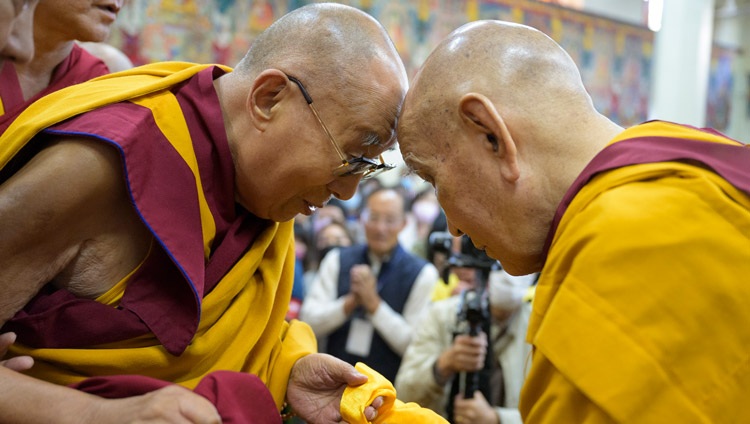
In the temple His Holiness warmly greeted the Ganden Throneholder and took his seat on the throne. The ‘Heart Sutra’ was chanted in Chinese, following which a mandala was offered to him.
“Today we’re going to hold a spiritual discourse,” His Holiness began. “When I was on my way here, listening to your chanting the ‘Mig-tsé-ma’ prayer to Jé Tsongkhapa reminded me that not only was I born close to his place of birth, but that I also share his philosophical views. However, the survival of the Buddhadharma is not linked to a particular location and those of us in exile have done our best to keep it alive. Jé Rinpoché’s teaching has spread around the world and I’ve done my best to clarify it.
“When I was in Tibet, and also since leaving the Land of Snow, one of my most important practices has been to read the 18 volumes of Jé Rinpoché’s Collected Works. I have a special regard for them and feel a close connection to them. Today, I’ll read his ‘Three Principles of the Path’.
“Tibetans’ core identity is focussed on the Buddhadharma. We have kept it alive and we have kept it well through study and practice. Consequently, many who have an interest in the Dharma are paying attention to our tradition.
Tea and bread served to the congregation were blessed with the recitation of a verse that celebrates His Holiness’s names:
I pray to you, O Supreme Noble Lotus Holder (Padmapani):
You are the adamantine Gentle Glory who has Mastery of Speech,
Your vase of Sublime Insight is replete with the nectar of Exalted Wisdom,
And you are embellishing jewellery of (Beautifully adorning) the Vast playful Ocean of Upholders of Dharma!
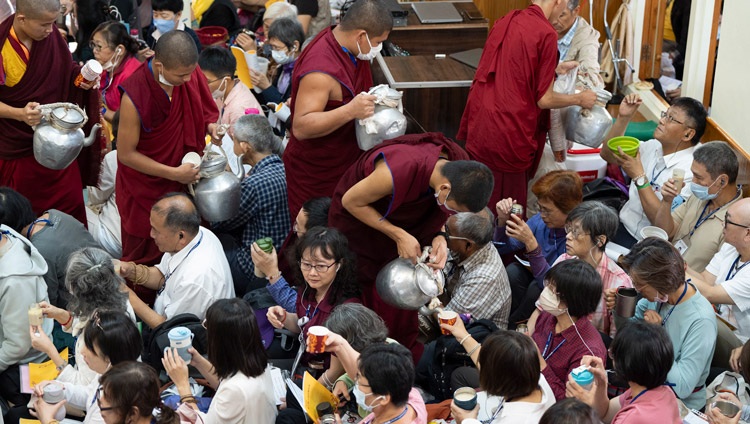
“There was a prediction at the time of the Buddha,” His Holiness continued, “that the Buddhadharma would spread from the north to the north. After his enlightenment the Buddha began his teaching by explaining the Four Noble Truths. In due course, what he had to say spread throughout Tibet, which is north of India, and on to Mongolia, which is north of Tibet. Tibetans in Tibet and in exile have kept the tradition alive through study and practice of the Three Higher Trainings—ethics, concentration and wisdom. Interest has grown around the world because these trainings are rooted in reason and logic.
“The three principles of the path are renunciation, or a determination to be free, the awakening mind and the correct view. The determination to be free does not lead to enlightenment directly, it needs to be augmented by the other two principles.
“Shantarakshita, among Indian masters invited by Tibetan kings to Tibet, established the Buddha’s teachings there. We have studied and meditated on what was taught and put the Three Higher Trainings and the Three Principles of the Path into practice.
“When we develop a determination to be free, we’ll no longer be drawn to the pleasures and attractions of this life or future lives in cyclic existence. We’ll turn away from them. However, we will not reach the state of omniscience without the awakening mind of bodhichitta and a correct view of emptiness.
“From the very beginning of my day I cultivate the awakening mind and an understanding of emptiness. When I hear sad news, these principles help me develop a determination to be free. Understanding the workings of the mind and emotions, and seeing how things are dependently arisen, we can come to an appreciation that suffering is rooted in ignorance.
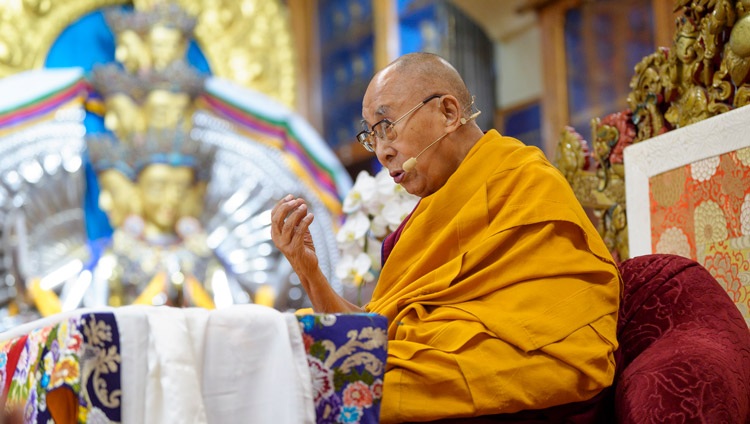
“The Three Principles of the Path need to be integrated within us. They need to become part of our inner experience.”
His Holiness began to read briskly through the text noting that without a pure determination to be free there is no way to still attraction to the pleasures of cyclic existence. We need to reverse attraction to this life as well as reversing attraction to future lives. When we do not for an instant wish for the pleasures of cyclic existence, and day and night remain intent on liberation, we will have produced a determination to be free.
However, a determination to be free without a pure awakening mind of bodhichitta does not bring forth enlightenment. Therefore, Bodhisattvas generate the excellent awakening mind. They reflect on how all beings, our mothers, are swept by the current of the four powerful rivers, tied by strong bonds of actions so hard to undo, caught in the iron net of self-centredness, completely enveloped by the darkness of ignorance, born and reborn in boundless cyclic existence, and are ceaselessly tormented by the three miseries. Thinking of them in this way they generate the awakening mind.
The text touches on how, despite these realizations, without wisdom, the realization of emptiness, we cannot cut the root of cyclic existence. Therefore, we must strive to understand dependent arising.
Jé Tsongkhapa states that appearances are infallible dependent arising, while emptiness is free of assertions. But as long as these two understandings are seen as separate, we will not have realized the intent of the Buddha. And yet, when these two realizations are simultaneous and concurrent, analysis of the profound view is complete. He goes on to reveal that appearances refute the extreme of existence, and emptiness refutes the extreme of nonexistence. When we understand the arising of cause and effect from the viewpoint of emptiness, we will not be captivated by either extreme view.
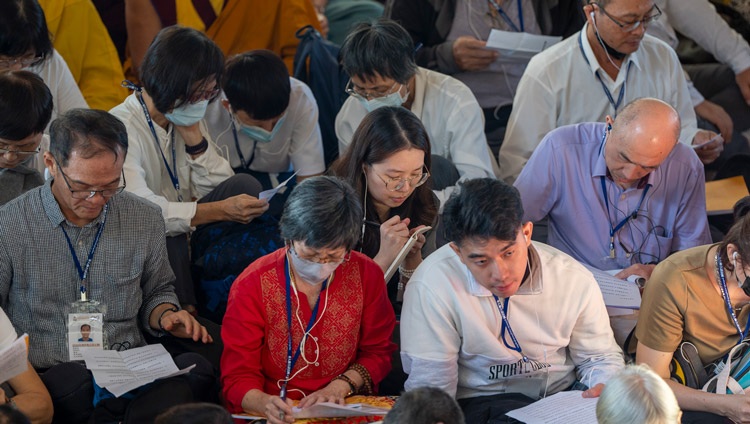
Jé Rinpoché counsels his disciple Ngawang Drakpa, to whom he sent these verses to realize the Three Principles of the Path, to depend on solitude and strong effort, and quickly reach the final goal.
His Holiness announced that he would offer the Bodhisattva Vow. He remarked that he finds reading books about the awakening mind of bodhichitta and its qualities, such as Shantideva’s ‘Entering the Way of a Bodhisattva’ to be both moving and inspiring. He said such books encourage us to work for all sentient beings throughout space.
“When the Buddha first set out on the path to enlightenment,” His Holiness advised, “he generated such an awakening mind. We should emulate him.”
His Holiness read the verses for taking refuge in the Three Jewels and generating the awakening mind, encouraging members of the congregation to generate the awakening mind and take the Bodhisattva vow themselves. Next, he repeated verses from ‘Entering into the Bodhisattva’s Way’ in celebration.
Today my birth is fruitful, my human life is justified. Today, I am born into the family of the Buddha, now I am a child of the Buddhas.
So that there may be no blemish upon this spotless family, I must now act as becomes my family.
“People around the world seem obsessed with weapons and the use of force,” His Holiness observed. “As practitioners of the Buddhadharma we should avoid this. Nothing good comes from the use of force. Killing so many people only brings further suffering. Setting aside attachment, anger and hatred we should work instead to benefit all sentient beings. Much better that developing bodhichitta within ourselves should be our primary aim.”
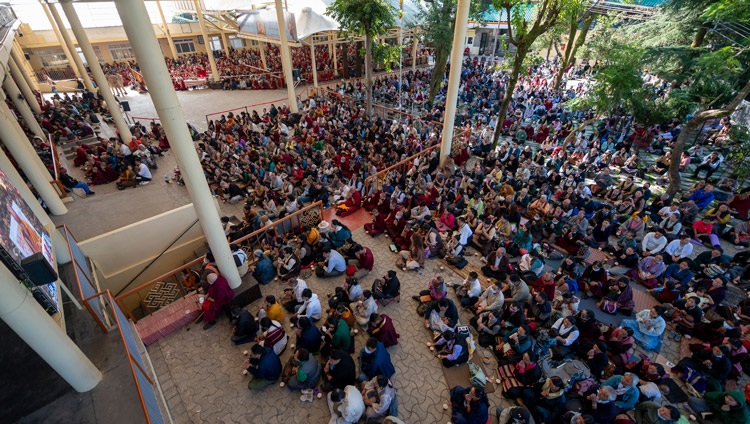
Among several questions from the audience His Holiness was asked what is the main cause not to be separated from the spiritual master. He answered that heeding the teachings you’ve received and putting them into practice creates a strong link with your teacher.
Another questioner wanted to know whether steady cultivation of practices like the exchanging of self and others would lead to genuine experience. His Holiness replied that if you familiarize your mind with such practice, it will eventually give rise to experience. In terms of bodhichitta you’ll feel ever closer to it. He repeated the verse concerning the four immeasurable wishes.
May all beings have happiness and the causes of happiness.
May all beings be free from suffering and the causes of suffering.
May all beings rejoice in the well-being of others.
May all beings live in peace, free from greed and hatred.
“If we familiarize ourselves with bodhichitta, in time we will become imbued with it. I cultivate bodhichitta and the view of emptiness on a daily basis and I feel it has created a solid experience within me.”
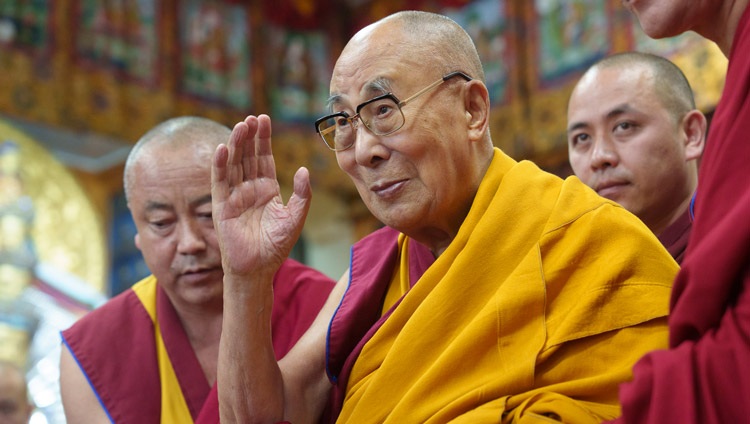
Asked how a beginner should act to prevent their sense of bodhichitta from slackening His Holiness simply advised that if you persevere with a practice, it will not decline. Finally, he declared that main cause of higher rebirths in the future is to cultivate the awakening mind of bodhichitta and an understanding of emptiness.
The Taiwanese disciples expressed their pleasure at His Holiness’s advice with a burst of applause. He left the temple, walked steadily to the lift, smiling at well-wishers as he went, and in the courtyard boarded the golfcart that would carry him home.












